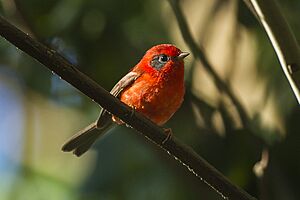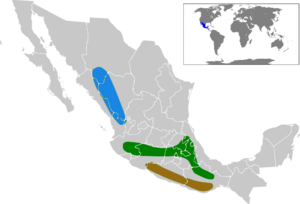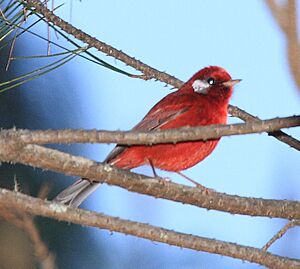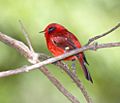Red warbler facts for kids
Quick facts for kids Red warbler |
|
|---|---|
 |
|
| Cardellina rubra melanauris Sinaloa, Mexico |
|
| Conservation status | |
| Scientific classification | |
| Genus: |
Cardellina
|
| Species: |
rubra
|
 |
|
| Range of the red warbler Blue = ssp. melanauris green = ssp. rubra brown = ssp. rowleyi |
|
| Synonyms | |
The red warbler (Cardellina rubra) is a small, bright red bird. It belongs to the New World warbler family. This bird lives only in the highlands of Mexico, north of the Isthmus of Tehuantepec. This means it is endemic to that area.
The red warbler is very similar to the pink-headed warbler, which lives in southern Mexico and Guatemala. They are so alike that scientists call them a superspecies. There are three types, or subspecies, of red warblers. They look a little different in the color of their ear patches and how bright their red feathers are. Adult birds are bright red with either a white or gray ear patch. Young birds are pinkish-brown with a whitish ear patch and two pale stripes on their wings.
Red warblers usually lay eggs between February and May. The female builds a dome-shaped nest on the ground. She lays three or four eggs and sits on them to keep them warm. Both parents feed the baby birds. The young birds are ready to fly in about 10 to 11 days. Red warblers eat insects. They find their food mostly in shrubs close to the ground. Even though this bird is not considered in danger by the International Union for Conservation of Nature (IUCN), its numbers might be going down. This is mainly because their homes are being destroyed.
Contents
About the Red Warbler's Name
Scientists give every animal a special name. The red warbler's scientific name is Cardellina rubra. The word rubra is Latin for "red," which makes sense because of its color!
For a long time, scientists thought the red warbler belonged to a different group of birds. But in 2010, new studies looked at the birds' DNA. This research showed that the red warbler and the pink-headed warbler are very closely related. Because of this, they were moved into the Cardellina group.
Different Types of Red Warblers
There are three different subspecies of the red warbler. They look a little different from each other:
- C. r. rubra: This type has white ear patches. It lives in areas from southern Jalisco to Oaxaca in Mexico.
- C. r. melanauris: This type has dark gray ear patches. Its red feathers are also a bit brighter. The name melanauris comes from Greek and Latin words meaning "dark ear." You can find this subspecies from southwestern Chihuahua to northern Nayarit.
- C. r. rowleyi: This type also has white ear patches. Its red feathers are the brightest of all three subspecies. It lives in the Sierra Madre del Sur mountains, from Guerrero to southern Oaxaca.
What Does a Red Warbler Look Like?
The red warbler is a small bird. It is about 12.5 to 13.5 centimeters (5 inches) long. It weighs about 7.6 to 8.7 grams (0.3 ounces).
Adult red warblers are mostly red. They have a patch of color on each side of their head, near their ears. This patch can be white or dark gray, depending on the subspecies. Their wings and tail are a slightly darker, dusky red. Their legs are a dull red-brown. They have a thin, pinkish-gray bill with a dark tip. Their eyes are dark brown or black. Male and female red warblers look very similar. Females might be a little duller or more orange-colored.
It's hard to confuse an adult red warbler with other birds in Mexico. Other red birds, like the scarlet tanager, are much bigger.
Young red warblers look different. They are pinkish-brown with a whitish ear patch. Their wings and tail are darker, but they have pinkish-cinnamon edges. They also have two lighter stripes on their wings.
Red Warbler Sounds
Red warblers make several different sounds. They have a high, thin tsii call and a stronger pseet call. Their song is a mix of short trills and richer warbles. It also includes high-pitched chips. They usually sing only in the bright morning hours during the breeding season. They sing less when it's cloudy.
Where Red Warblers Live
The red warbler lives only in the highlands of Mexico. It does not live along the coasts. It is quite common in the middle of the country. These birds live at high elevations, from about 1,800 to 3,900 meters (5,900 to 12,800 feet) above sea level.
They live in humid or semi-humid forests. These forests have pine, pine-oak, and fir trees. During the breeding season, they stay in higher areas. In winter, they move to lower elevations, often in oak forests. They are one of the most common small birds in their forest homes.
Red Warbler Behavior
Red warblers are usually found alone or in pairs. Sometimes, they might join groups of different bird species. Young birds probably find a mate in the fall of their first year. Pairs stay together all year.
Reproduction and Life Cycle
The red warbler breeds mostly in early spring, from February to May. The male bird chooses a territory and defends it with his song. He chases other males away.
The female builds the nest by herself. This usually takes 4 to 6 days. She picks a sunny spot on the ground for the nest. It might be in a clearing or near a trail. The nest is shaped like an oven, with an opening on the side or top. It is hidden in plants on the ground. The nest is made of pine needles and grass. Sometimes, it also has lichens, moss, and leaves. The inside of the nest is neat and lined with fine grasses.
The female usually lays three eggs, but sometimes four. The eggs are pale pink or white with brown spots. They are about 16 to 17 millimeters (0.6 inches) long. The female sits on the eggs for 16 days to keep them warm. The male does not come near the nest until the eggs hatch.
Both parents feed the baby birds. They also remove fecal sacs (waste) from the nest. The parents are careful when they approach the nest. They might pretend to look for food nearby. They stay only a few seconds at the nest. This makes it harder for predators to find the young birds. The baby birds make a high-pitched peeping sound when a parent brings food. They are ready to fly in 10 to 11 days after hatching. Young birds are fully grown three weeks after they fledge. Then, their parents make them leave the nest area.
What Red Warblers Eat
The red warbler is an insectivore, meaning it eats insects. It finds insects mostly in shrubs close to the ground. It moves slowly and carefully, looking for food in cracks in tree bark and among pine needles. Sometimes, it hovers in the air to grab insects from pine needles. It can also climb on branches, even hanging upside down, to find prey. In areas with deciduous trees (trees that lose their leaves), it often catches flying insects from a perch.
Red warblers usually do not feed after sunset. However, they might do so if there is a lot of food available, like newly hatched insects.
Safety and Threats
Small hawks, like the sharp-shinned hawk, might hunt red warblers. Their nests can be raided by wrens, rodents, raccoons, cats, and snakes.
Interestingly, the red warbler is not good to eat. In the 16th century, people in Mexico knew that this red bird was inedible. Scientists have found special chemicals in their feathers that make them taste bad.
Conservation Status
The red warbler is currently listed as a species of least concern by the International Union for Conservation of Nature (IUCN). This means it is not in immediate danger of disappearing. Even though its numbers seem to be going down, the decline is not very fast. There are still many red warblers, estimated to be between 50,000 and 499,999 birds.
However, the forests where they live are facing threats in Mexico. Things like logging, expanding farms, gathering firewood, building roads, and city growth are destroying their homes. But, there is some good news: cutting down some trees in pine forests might actually help this bird. This is because red warblers prefer more open, sunny areas for breeding.
Images for kids
-
Cardellina rubra melanauris
Sinaloa, Mexico










